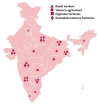The Cultural Tapestry of Tobacco Use in India: A Narrative Review
- PMID: 40726884
- PMCID: PMC12301530
- DOI: 10.7759/cureus.86884
The Cultural Tapestry of Tobacco Use in India: A Narrative Review
Abstract
In India, both smoking and nonsmoking forms of tobacco are deeply ingrained in cultural and regional customs. Being the largest producer and consumer of tobacco, India witnesses a wide variety of cigarettes, bidis, hookah, chilam, ghutka, pan masala, khaini, and betel quid with tobacco. The consumption of these products is based on sociocultural notions with variations across education, gender, and geography. Historically, smoking is linked with masculinity and authority, especially in rural areas. At the same time, female tobacco use is prevalent in neighboring countries like Bangladesh despite being stigmatized in Indian society. There, women cite oral health benefits and enhanced concentration as justification for consumption. The multifactorial behavior of tobacco consumption is influenced by social and cultural norms and practices. Hookah, cigars, and shisha often symbolize status in social gatherings. In the face of growing knowledge and awareness of its health hazards, strong association with oral precancerous lesions such as oral submucous fibrosis, erythroplakia, and leukoplakia, tobacco remains dangerously addictive and tough to quit. Significant geographic clustering was observed in different states and union territories of India, showing regional influences. Public health initiatives in India should be culturally tailored and area-specific, owing to the strong tobacco habits and cultural underpinnings. Targeted policy modifications that are cognizant of local customs and habits may boost the impact and efficacy of tobacco control programs and substantially lower the nationwide tobacco-related health burdens.
Keywords: india; tobacco.
Copyright © 2025, More et al.
Conflict of interest statement
Conflicts of interest: In compliance with the ICMJE uniform disclosure form, all authors declare the following: Payment/services info: All authors have declared that no financial support was received from any organization for the submitted work. Financial relationships: All authors have declared that they have no financial relationships at present or within the previous three years with any organizations that might have an interest in the submitted work. Other relationships: All authors have declared that there are no other relationships or activities that could appear to have influenced the submitted work.
Figures
References
-
- Sinha SK, Pal R, Ghosh A, Rana RK. Tobacco and Public Health: Tobacco and Community Well-Being---A Worldwide Health Crisis. Chhatisgarh: Shashwat Publication; 2024. Background history about tobacco.
Publication types
LinkOut - more resources
Full Text Sources

